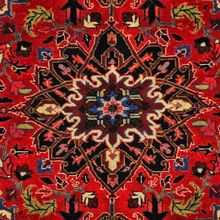Difference between revisions of "Sharabian Rug"
| Line 46: | Line 46: | ||
=== Color and dyeing === | === Color and dyeing === | ||
=== Motifs and Designs === | === Motifs and Designs === | ||
| + | Sharabian background designs are nearly [[Geometric Design|geometric]] or quasigeometric, featuring [[Medallion Design|medallion]] or all-over styles. The motifs include palmettes, leaves, and vines, with primitive nomadic design elements.<ref>Moheban, 2015, p.526-527</ref> | ||
| + | |||
=== Weaving techniques === | === Weaving techniques === | ||
== See also == | == See also == | ||
Revision as of 11:54, 11 December 2019
| Sharabian Rug | |
|---|---|
 Design of Sharbian Rug (Rugman) | |
| General information | |
| Name | Sharbian Rug |
| Original name | قالی شربیان |
| Alternative name(s) | Sharbian Carpet |
| Origin | |
| Category | Village |
| Technical information | |
| Common designs | Geometric, Medallion |
| Common colors | Black, Navy Blue, Red, Blue, Ivory |
| Dyeing method | Natural, Synthetic |
| Pile material | Wool |
| Foundation material | Cotton |
| Knot type | Symmetrical (Turkish) |
Sharbian rug originate from Sharbian, located in the Province of Azerbaijan in northwestern Iran close to Heriz. Sharbian enjoys the same rich history of Persian carpet making as its neighbor Heriz. Due in large part to their close proximity geographically, the similarities in both color and design in a Persian carpet from Sharbian and one from Heriz are quite striking. The art of Persian carpet weaving in Sharbian is much as it was thousands of years ago. The skilled artisans learn their craft from elder family members and it continues even today to be passed down through the generations. The looms used to create Sharbian rugs have not changed much in millennia and Turkish knots are still used.
History
Sharabian is a village located in the East Azerbaijan Province of northwestern Iran. It is situated close to the famous weaving village of Heriz. The population is Azeri tribe in origin and speaks a Turkic dialect. Sharabian carpet production started when the demand for Heriz carpets grew in the world marketplace during the turn of the twentieth century. Sharabian carpets ve Heriz design styles and are grouped under the Heriz carpet name.
After World War II, great quantities of Sharabians were produced for the domestic market and foreign export to the West.[1]
Materials
Foundation and Pile
Techniques and structures
Color and dyeing
Motifs and Designs
Sharabian background designs are nearly geometric or quasigeometric, featuring medallion or all-over styles. The motifs include palmettes, leaves, and vines, with primitive nomadic design elements.[2]
Weaving techniques
See also
References
Bibliography
Abraham Levi Moheban, (2015), The Encyclopedia of Antique Carpets: Twenty-Five Centuries of Weaving, NewYork: Princeton Architectural Press.